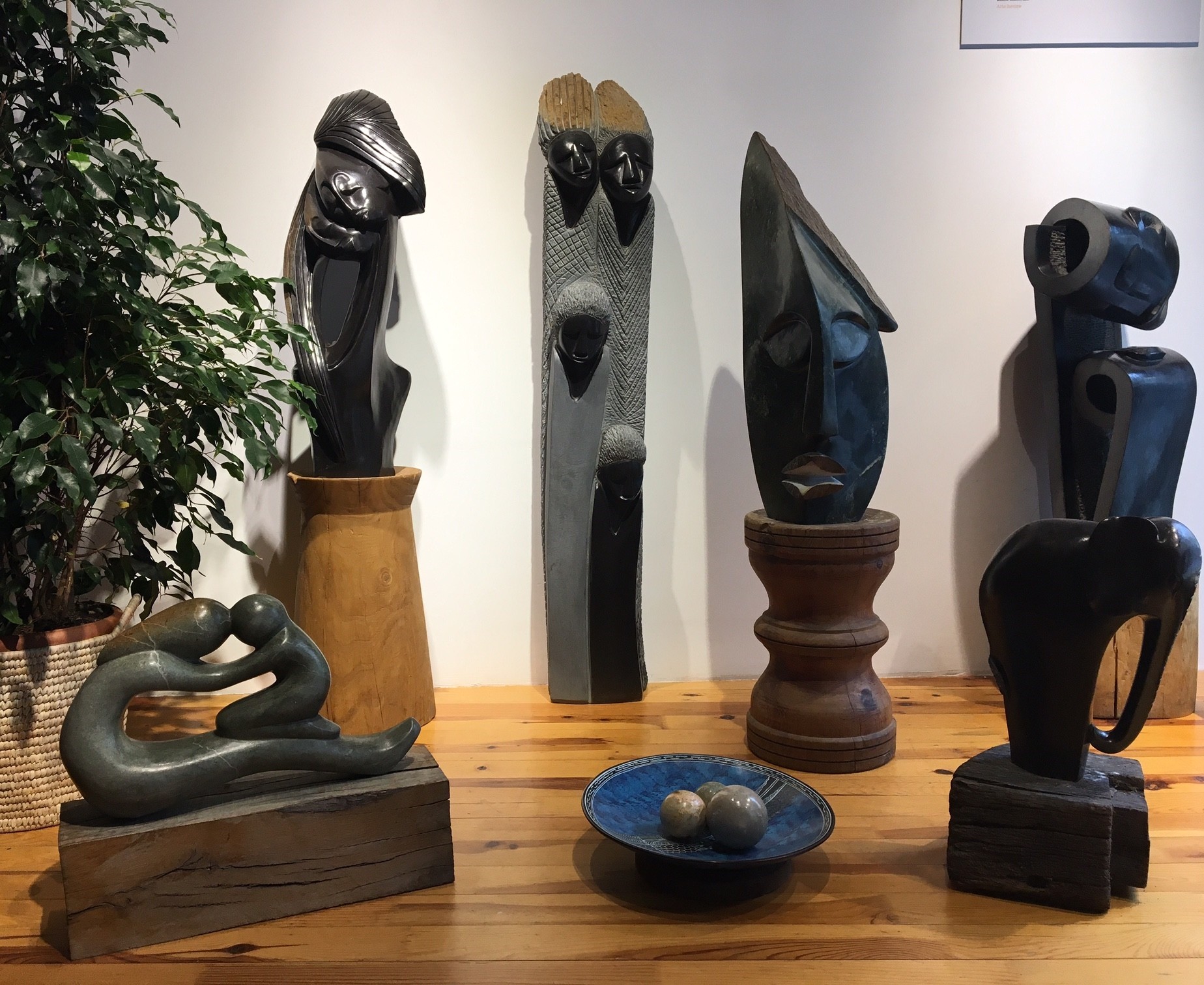Klip Kuns Stone Art: A Revival of Afro-Indigenous Cubism in Istanbul
Gamze Alpar is an unrivaled curator and dynamic hostess, as she warmly invites art connoisseurs and the most curious of Istanbul wanderers for tea and conversation surrounded by examples of the priceless tangible heritage of Zimbabwe, where she has traveled. for the first time last April. and shortly thereafter for three months in the summer. She followed in the footsteps of an old friend in Kenya to collect Shona stone art with her partner Murad Geyimci before returning to Istanbul for the September opening of her gallery, Klip Kuns.
Last year, Gamze Alpar visited Zimbabwe for the first time and became a collector of Shona art before opening Klip Kuns in Istanbul.
In Old Harare, she discovered that there are around six hundred Shona artists in Africa who remain dedicated to the craft that continues to place African sculpture among the latest trends in contemporary world art long after revolutionizing painting from the 20th century. The works of Picasso and his French contemporary Georges Braque speak of one of the most dramatic transformations in the history of art, that of the development of cubist painting from African sculpture.
In Afrikaans, Klip Kuns simply means “art of stoneâ€. It signifies an indigenous African craft tradition with singular contemporary relevance to the world of visual arts, especially from the origins of Modernist painting, and ultimately from time immemorial. African visual art is sometimes still typically stereotyped in primitivism, as composed of ceremonial masks and West African sculptures. Shona art, however, has been hailed in the international press and in the world’s most prestigious museums as the perfect embodiment of indigenous modernism, as its artists continue to shatter all the clichés, labels and conventions known to exist. interpose between European thought and the understanding of contemporary African culture.
The earliest European appreciation of African art within the modernist core is largely attributed to the writings of the German Jewish anarchist and critic Carl Einstein, whose most important work “Negerplastik” is about sculpture and directly influenced painters. avant-garde of the interwar period. At the time of its publication in 1915, Zimbabwe was Southern Rhodesia, effectively ruled by the colonial British mining industry which subdued several Shona rebellions. Afrikaans was then a minority language and its presence would soon disappear from the ground in 1980 with the independence of Zimbabwe, where the current ethnic majority language, Shona, was the most widely spoken after English.
In remembrance of Zimbabwe’s colonial era, when Shona art gained international audiences as a distinct and world-class aesthetic discipline, keeping the Afrikaans name of Klip Kuns pays homage to the social history of the movement. of contemporary sculpture that emerged from the landlocked south. African country of present-day Zimbabwe, whose name literally translates to “Stone House”. In the years leading up to independence, Zimbabwean artists found a space abroad to freely meet in the world of international art exhibitions.
Joram Mariga, the father of Zimbabwean sculpture is pictured at Klip Kuns above his exquisite pieces, all by living artists who follow his legacy on the gallery floor. He was among the first modern Shona artists to exhibit abroad, notably in 1963 at the Royal Festival Hall in London, under the wing of the English museologist Frank McEwan who founded what is today the National Gallery of Zimbabwe. For the next 16 years before Zimbabwe became an independent nation and despite Western sanctions against the openly racist Rhodesian government, Shona art has been staged at the world’s finest art institutions, from MoMA in New York to the Museum. Rodin in Paris and beyond.

Taurai Chimba is unique among the new generation of Shona artists, as it has gained international fame thanks in part to the special efforts of Klip Kuns.
In 1969, American fashion designer Mary Josephine McFadden married McEwan in Rhodesia when Vukutu was established, an artist community for Shona sculptors called Workshop School. Although the marriage lasted for a year, performers from her sculptural farmhouse now honor the pantheon of Shona performers. They are now celebrated at Klip Kuns. The portraits of Nicholas Mukomberanwa, Henry Munyaradzi and Joseph Ndandarika recall the inspired ingenuity that arose out of Vukutu, providing art historians and aesthetes around the world with a clear and expansive view of a history of African independence through the production of fine arts.
Alpar displays the core values ​​of Shona sculpture with multi-faceted sophistication on his gallery in a flowing open-door exhibition style incorporating textual and photographic elements to embellish hundreds of ingenious sculptures from around 50 artists. She has personally met most of the artists in her gallery whose works she organizes for niche art markets in Istanbul and around the world. Taurai Chimba, for example, is a rare name in international spotlight among new Shona artists. Two of his soapstones at Klip Kuns depict mythical and playful characters that recall the Inuit aesthetic of the native Arctic, but with a very unique and authentic formalism that leaves aficionados wondering how cubism and Shona art differ at all.
On any day, Alpar receives visitors and clients from across the globalized social spectrum at Klip Kuns, such as American ironworker and ceramic artist Castro, who talks about the history of art and creative independence. with rare ease, also demonstrated by his special talent. When asked if he is inspired by Shona art, he quickly replies in the negative. For him, appreciation of the arts and creative work are worlds apart. He confidently affirms the pure and individualistic originality of his profession while evoking the debt of famous painters to the African sculptors who inspired Cubism.
Where an instantly recognizable nude sketch of Picasso gazes out from a ledge on one of the gallery’s many walls adorned with Shona sculptures, Castro shared lucid reflections on African art and artistic integrity as Alpar delved into it. the conversation with exciting bursts of insight from his unrivaled experience as the only Turkish curator wholly dedicated to Shona art. She reflects comfortably on everything from her days in Zimbabwe to a recent loan from the Klip Kuns gallery for the shooting of a new film by Serra Yılmaz and Ferzan Özpetek.
Shona artists carve butter jade, serpentine, spring stone, black and white opal, verdite and soapstone to evoke vast ranges of emotions from the mineral surface. As is traditional in the indigenous philosophy of Shona art, the stones are believed to take a sculptural form by the will of the ancestral spirits. Artists refrain from making premeditated sketches and using sophisticated tools beyond simple pickaxes and cutters so as not to interfere with the creative source.
Wildlife and villagers are among the recurring topics that fit the transgender definition of neorealistic naturalism, such as the ribbed rhino by Yardaro R. Mudenda. And there are abstract and expressionist pieces closer to Cubist affinities, as in the monolithic portraits of Second Mappfumo and Nhamo Iasi exhibited at Klip Kuns alongside pieces innovated in the same way with titles like “Matrix”, “Spiral Face” , “Wise” and “The Storm God”. Other works, such as “Eagle” and “Love” demonstrate a syncretic aesthetic that blends equally sophisticated techniques behind traditional forms and contemporary stylizations.
Klip Kuns is the only gallery in Turkey, and potentially the world, to focus solely on Shona art. Its aesthetic philosophy contrasts with special significance next to traditional Turkish art, as there is no comparable stone carving tradition in Turkey given the historic Islamic prohibition against carved images. Alpar is wide-eyed and ambitious. She is already planning winter adventures in Zimbabwe to strengthen her ties with the local craft community while setting her sights on Toronto, Dubai, Paris and elsewhere to expand the creative space for contemporary Shona art to continue to flourish with. distinction all over the world.

